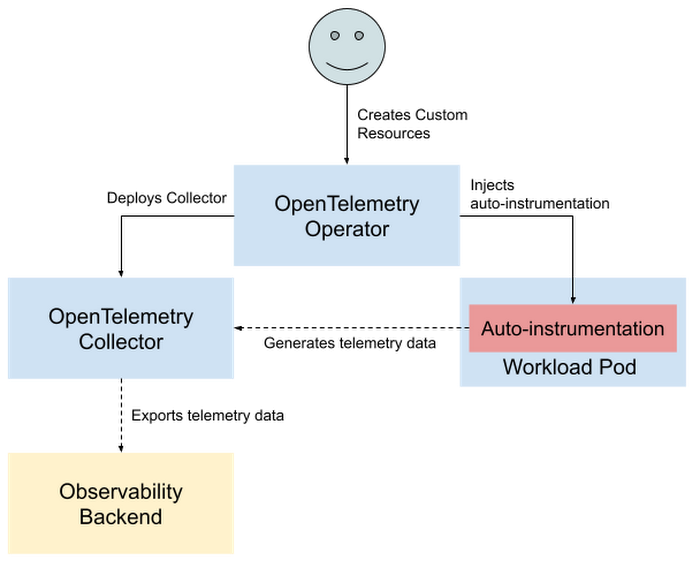Easy Telemetry Instrumentation on GKE with the OpenTelemetry Operator
Mike Dame
Software Engineer
Easy Telemetry Instrumentation on GKE with the OpenTelemetry Operator
In recent years, the application monitoring landscape has exploded with instrumentation libraries, SDKs, and backends for storage and visualization. But a major friction point is still the investment required to instrument applications with these libraries, and libraries are often tied to a small set of telemetry backends.
The OpenTelemetry project has tried to address these problems with its open standard for telemetry data, multi-lingual instrumentation libraries, and “auto-instrumentation” of applications without needing code changes. The community has also created a Kubernetes Operator to automate some of these solutions in containerized environments.
The OpenTelemetry Operator is designed to provide auto-instrumentation to export traces and metrics in new and existing applications without any code changes. It also automates the deployment of OpenTelemetry Collectors, which offer vendor-agnostic monitoring pipelines. These two features help simplify both the onboarding process for new users and the day-to-day operational burden of monitoring fully-instrumented applications.
Across this spectrum of use cases, we’ve identified a few common problems that can be easily solved using the OpenTelemetry Operator. We gathered these under a single GitHub repository (https://github.com/GoogleCloudPlatform/opentelemetry-operator-sample) with the goal of providing a set of samples and walkthroughs for installing and working with the Operator. In this post, we’ll talk about some benefits of the OpenTelemetry Operator and how to use it.
Getting started with the OpenTelemetry Operator
The two main functions of the Operator are managing OpenTelemetry Collectors and auto-instrumenting applications. You can configure these Collectors and instrumentation through Custom Resources (explained in more detail later in this post).


The Operator is fairly simple to install once you have a GKE cluster provisioned. The only prerequisite is to install cert-manager, which the Operator uses to manage its webhook certificates. On GKE Autopilot, the easiest way to do this is with Helm (which allows passing extra arguments to work with Autopilot, which we’ve documented in the repo).
Ultimately, the Operator is installed with a single kubectl command such as:
After a few moments, you’ll see the Operator running in the opentelemetry-operator-system namespace, eagerly waiting to serve your telemetry needs. But for it to actually do something, we need to have it set up a Collector.
Deploying and configuring the Collector
The first main feature of the Operator is that it can install, manage, and configure instances of the OpenTelemetry Collector. For background, the Collector works with numerous plugins to process and export telemetry data. That data can be ingested from a variety of sources with receivers, modified in-transit with processors, and reported to several popular telemetry backend services with exporters. Essentially, it provides a routing solution for flexible, vendor-agnostic, and instrumentation-independent observability.
Setting up the Collector with the Operator is done by creating an OpenTelemetryCollector object. This is a namespaced Custom Resource, so it is created in the same Namespace you want the Collector to run in, for example:
The OpenTelemetryCollector object has numerous settings to control how the Collector is deployed. For example, it can be deployed as a sidecar container by setting mode: sidecar like so:
The Operator will then inject the Collector sidecar into any Pod that has the annotation sidecar.opentelemetry.io/inject: “true”. It’s a common pattern to run sidecar Collectors with resource detection, each forwarding telemetry to a load-balanced Collector service that exports the data. In that setup, the sidecar Collector can detect accurate resource information for the Pod while the service Collector can handle processing and exporting in one place.
Using the OpenTelemetryCollector object also provides an easy way to set a specific container image to use for the Collector. This is really useful for working with custom Collectors, such as those built with the Collector builder tool (see our sample repository for working with the Collector builder at https://github.com/GoogleCloudPlatform/opentelemetry-collector-builder-sample). Custom-built Collectors allow you to completely control the build and deployment pipeline for your Collector, offering the ability to strip down a Collector to only the components you need. The resulting image saves space and reduces the dependency surface area for security risks.
For example, run a custom Collector image with the following config change:
Once the Collector is deployed, the Operator will monitor it to ensure it’s active but also to make sure it is reconciled to remain consistent with the settings you provide. For example, when changing the Collector’s config or creating new Pods with a sidecar annotation. But deploying the Collector is only one of the Operator’s features, the other big feature being its ability to manage auto-instrumentation of applications.
Adding auto-instrumentation to Pods and Deployments
The second main feature of the Operator is that it provides easy auto-instrumentation for telemetry. Because even with a Collector ready to ingest and route your telemetry, you still need to instrument your applications to report some data. In general, instrumentation can be done either manually or automatically. While manual instrumentation involves the process of modifying application code to use OpenTelemetry SDKs, automatic instrumentation uses OpenTelemetry agents to inject instrumentation into your program at runtime.
Obviously, the option of auto-instrumenting your applications comes with less engineering investment than manual instrumentation. This makes it great for rapidly onboarding to OpenTelemetry, and is currently available for applications written in Java, NodeJS, Python, and .NET. It is even possible to combine auto-instrumentation across languages, making it useful for a system design with multi-language microservices.
The OpenTelemetry Operator provides this auto-instrumentation through mutating webhooks that inject a sidecar container into the application Pod’s specification. This sidecar container provides instrumentation agent code and shares a filesystem with the Pod’s main container so that it can inject traces into the application. Most importantly, it does all of this without the need to write any code.
To get started with auto-instrumentation, first create an Instrumentation object to define your desired instrumentation settings (such as sample rate):
Like OpenTelemetryCollector objects, Instrumentation is also a namespaced Custom Resource. Namespacing in this case gives you finer control over the auto-instrumentation settings that are passed on to different parts of your application (though Pods can reference Instrumentations across Namespaces too).
The Operator will map these settings to an annotation on corresponding application Pods. This annotation takes the form of instrumentation.opentelemetry.io/inject-<LANGUAGE> and it’s how you opt-in a Pod for auto-instrumentation. For example, to auto-instrument a Pod running a Java application, add the following annotation to the Pod’s metadata:
|
The my-instrumentation value refers to the name of the Instrumentation object created earlier. This can also be set to an Instrumentation object from a different namespace, or true to pick a default Instrumentation from the current namespace, or false to explicitly opt the Pod out from auto-instrumentation. These options offer the flexibility to mix and match different instrumentation configurations in a system by referring to different configurations on different services. The full list of available annotations is documented on the Operator’s GitHub.
Once a Pod is annotated, the Operator will automatically pick up the change and update the Pod spec to include the auto-instrumentation sidecar container. The same type of annotation can be used for Pods within a Deployment (or any kind of replica controller, such as a CronJob or ReplicaSet). Simply set the annotation on the Pod template metadata defined in the Deployment. For example, instrument a Python application by adding the annotation to its Deployment as shown in bold below:
It’s important to note that the annotation is in the metadata for the Pod template, not the Deployment. Alternatively, the annotation can be added to the metadata for a Namespace to apply the referenced Instrumentation configuration to all Pods in the Namespace. For example, inject the NodeJS auto-instrumentation to every pod in the my-node-app Namespace with the following command:
|
Annotating an entire Namespace like this is great for clusters with high churn (such as with serverless applications) or multi-tenancy setups, enforcing observability settings on tenant projects. Both of which show that auto-instrumentation is useful not just for experimenting, but for high-scale production workloads.
Our solutions repository for GKE users
The Operator makes it much easier to set up OpenTelemetry collection and auto-instrumentation than the alternative, manual process. However, we recognize that there are still a few steps that could be simplified and common setups to document, especially for new users who are just interested in trying it out for a quick demo. To help with this, we launched a new GitHub repository at https://github.com/GoogleCloudPlatform/opentelemetry-operator-sample focused on improving ease-of-use with the Operator.
Sample Apps
The repository includes ready-to-use configs, simplified commands for deploying and working with the Operator, and even a few sample apps written in various languages. These samples provide an end-to-end demonstration of setting up the Operator, configuring the Collector, and adding auto-instrumentation for a variety of use cases.
One of these samples is a basic client-server NodeJS app meant to showcase auto-instrumentation without any code modifications. Build this app yourself and run it alongside the Operator to play with auto-instrumentation and get a hands-on understanding of how it works before adding it to your existing workloads:
Replace our sample app with your own production NodeJS application and the process is identical (just add annotations!).
Whether you’re experimenting with sample apps or already auto-instrumenting your production workloads, the recipes shown in this repository are meant to walk you through the next step of configuring your telemetry ingestion pipeline.
Config Recipes
To demonstrate different use cases of the Operator, we’ve curated a set of recipes covering various Operator configurations. Each recipe works with the sample apps to enrich those demos, but they are also production-ready so there’s no difference between the steps to experiment and deploy them.
For example, the Cloud Trace integration recipe updates a Collector configuration to enable reporting to the GCP tracing backend. This is the same configuration you would use for a production application, and if you already have a Collector set up with the Operator it can be turned on with one command:
|
Over time, we plan to grow this repository with more configurations for different use cases. These off-the-shelf recipes are tailored for usability on GKE and preconfigured to work optimally with other GCP products like Cloud Build and Cloud Trace.
We want this repository to provide a source for both onboarding with OpenTelemetry and putting the Operator to use in production environments. This repository is open-source and accepting contributions, so if you have a request or problem to report feel free to reach out on GitHub.



